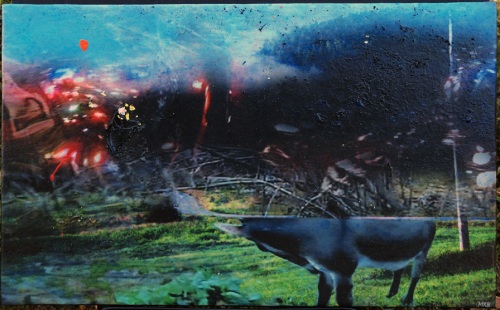
Dyrabend – målning av Max Book 2010, 48×77 cm
Detta är en reflektion som skrevs med anledning av höstens konstdebatt
i Svenska Dagbladet.
Den handlar om begreppet konstnärlig forskning.
SvD valde efter div. turer att inte publicera den, med argumentet att
den inte är en debattartikel,
vilket naturligtvis kan tyckas vara nog så sant.
Men vad är en debatt utan en reflektion vid årets slut ?
***********************
Anomalistisk konst
Jag vill här kort redogöra för min syn på begreppet konstnärlig forskning,
som har aktualiserats genom Moderna-utställningen just nu på
Moderna Museet, samt den efterföljande debatten här i SvD.
Mina resonemang behandlar på intet sätt något specifikt gällande
Moderna-utställningen, utan är en allmän betraktelse om begreppet
konstnärlig forskning.
Forskning är enligt Nationalencyklopedin en term som slog igenom vid
1800-talets mitt och förklaras som en process, vilken genom systematiskt
arbete kan frambringa nya kunskaper och ökat vetande.
Konsten, som vi generellt känner den, är också en fortgående process
som innefattar en specifik sociokulturell kongruens, s.k. kanon.
Denna skönsång står i uppenbar motsats till det konstnärliga skapandets
alla tänkbara uppenbarelseformer. Den utesluter vetande och kunskap
på grundval av den rådande tidens begär. Makten formar den sociala
skulpturen. Man genererar ett slags `mening´ genom att utesluta det
`meningslösa´. Plötsligt uppstår en treenighet bestående av begreppen –
meningsfull = kunskap = sanning.
Naturvetenskapen bygger också på en specifik sociokulturell kanon, och
är ingalunda den klädnad av `absolut´ vetande, som kanske är dess
allmänt vedertagna bevekelsegrund.
Det konstnärliga skapandet och dess uppenbarelseformer gjorde ett
radikalt annorlunda vägval under romantiken (sent 1700- tidigt 1800-tal).
Känsla, begär, skönhet och det enastående blev ledstjärnor som skulle
komma att skapa en ny estetik inom konst och filosofi. Begrepp som
social kongruens och kulturell kanon tappade lite av sina konturer där i
den tidiga romantiska dimman.
Naturvetenskapen blev far till en dotter, som var romantiken.
Dessvärre en vanartad sådan, som födde oönskade anomalier (vet. term
för avvikelser), på löpande band. Mary Shelley´s Frankenstein är t.ex.
en pregnant variant på hur skönhetsbegreppet vidgades till
groteska former.
Med anomalin upphöjd till norm och exemplifierad i ett otal konstriktningar
och -ismer, har det romantiska idealet fortsatt att färga vår konstuppfattning
ända in i dessa dagar.
Romantiken har även färgat naturvetenskapen. Det enastående i (geniet)
Einsteins relativitetsteori är en anomali, en avvikelse från det förväntade
enligt naturvetenskaplig norm. Jag vill tro att hans drivkrafter var ett
pockande begär efter skönhet. Något som är sig självt nog, en slutstation,
ett paradigm som upphäver sig självt. Äntligen något som var obegripligt
även för honom själv.
Korsdraget mellan vetenskap och konst har sedan dess bara fortsatt.
Hade t.ex. postmodernismen uppstått utan Einsteins relativitetsteori ?
För att kröka rummet och därmed tiden ni behöver offra för att läsa
detta ännu mer, hoppar jag nu direkt till det begrepp som föranlett
denna artikel. Konstnärlig forskning.
Kan det vara så att detta begrepp blir ännu en anomali som genererats
av ett i grunden romantiskt konstparadigm?
Eller är bevekelsegrunderna mer jordnära och monetära?
Om inget av dessa alternativ är relevanta, kan det vara svårt att utesluta
ett alltför intimt umgänge mellan far och dotter.
Sådant brukar dessvärre inte se så bra ut.
Man kan t.om. råka bli trött.
När jag lite senare, som i en dröm kommer körande med bil, bland
enstaka virvlande sedlar i den ekonomiska snålblåsten, verkar begreppet
konstnärlig forskning vara en lika ängslig som onödig rondell, utplacerad
invid nåt byråkratiskt svartbygge.
Dessutom, den smala glädjen i att se rondellen relativt glest trafikerad,
grusas snabbt när sikten fördunklas av det yviga skägget på en temporärt
utplacerad rondellhund.
Väl ute ur rondellen muterar vägen till en strid strömmande fors.
Jag räddar mig med nöd och näppe ur den sjunkande bilen, som
knakande och gnisslande försvinner ner i djupet.
I skydd av en buske blir jag sedan vittne till en upprörd diskussion
mellan Forskaren och Forskarlen. Jag lyckas uttyda grava menings-
skiljaktigheter gällande de fintrådiga myceliernas utbredning strax under
markytan, just där vid strandkanten.
Naturligtvis inget man kan se med blotta ögat.
Dock fylls jag av hopp när jag inser deras gemensamma begär efter
skönhet, även på ställen där inget mänskligt öga eller social kongruens når.
Väckarklockan ringer, och snoozeknappen glänser ack så vacker.
Det är allt jag begär.
Max Book
Kolartorp, Nov. 2010


